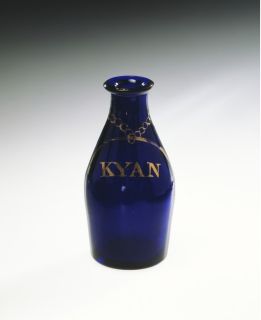Cruet
Cruet refers to a small container designed for holding liquids, typically used in culinary and religious contexts. These containers are often made of glass, ceramic, or stainless steel and come with a stopper or lid to prevent spillage. Cruets are commonly used to hold vinegar, oil, and other condiments in the dining setting, and holy water or wine in religious ceremonies.
History[edit | edit source]
The use of cruets can be traced back to ancient civilizations, where they were primarily used for storing precious oils and wines. The design and material of cruets have evolved over centuries, from simple clay pots to elaborately crafted glass or metal vessels. In the Middle Ages, cruets became a staple in religious ceremonies, especially within the Christian Church, where they were used to hold water and wine for the Eucharist.
Types[edit | edit source]
There are several types of cruets, each designed for a specific purpose:
- Vinegar and Oil Cruets: Often found in pairs, these cruets are a common sight on dining tables. They are designed to dispense vinegar and olive oil efficiently, usually featuring a narrow spout to control the flow of liquid.
- Mass Cruets: Used in Christian liturgy, these cruets hold the water and wine required for the celebration of the Mass. They are typically made of glass or silver and are more ornate than their culinary counterparts.
- Holy Water Cruets: These are used in various religious traditions to hold holy water. Unlike mass cruets, holy water cruets may be made of more durable materials to prevent corrosion or damage.
Design and Material[edit | edit source]
Cruets come in various designs, ranging from simple and functional to ornate and decorative. The choice of material—glass, ceramic, or metal—often depends on the cruet's intended use. Glass is a popular choice for both culinary and liturgical cruets due to its non-reactive nature and the ability to see the contained liquid. Ceramic and metal, particularly stainless steel or silver, are chosen for their durability and aesthetic appeal.
Cultural Significance[edit | edit source]
In addition to their practical uses, cruets hold cultural significance in many societies. They are often involved in rituals and traditions, symbolizing hospitality and community. In some cultures, presenting oil or vinegar in a beautifully crafted cruet is a sign of respect and friendship.
See Also[edit | edit source]
Search WikiMD
Ad.Tired of being Overweight? Try W8MD's physician weight loss program.
Semaglutide (Ozempic / Wegovy and Tirzepatide (Mounjaro / Zepbound) available.
Advertise on WikiMD
|
WikiMD's Wellness Encyclopedia |
| Let Food Be Thy Medicine Medicine Thy Food - Hippocrates |
Translate this page: - East Asian
中文,
日本,
한국어,
South Asian
हिन्दी,
தமிழ்,
తెలుగు,
Urdu,
ಕನ್ನಡ,
Southeast Asian
Indonesian,
Vietnamese,
Thai,
မြန်မာဘာသာ,
বাংলা
European
español,
Deutsch,
français,
Greek,
português do Brasil,
polski,
română,
русский,
Nederlands,
norsk,
svenska,
suomi,
Italian
Middle Eastern & African
عربى,
Turkish,
Persian,
Hebrew,
Afrikaans,
isiZulu,
Kiswahili,
Other
Bulgarian,
Hungarian,
Czech,
Swedish,
മലയാളം,
मराठी,
ਪੰਜਾਬੀ,
ગુજરાતી,
Portuguese,
Ukrainian
Medical Disclaimer: WikiMD is not a substitute for professional medical advice. The information on WikiMD is provided as an information resource only, may be incorrect, outdated or misleading, and is not to be used or relied on for any diagnostic or treatment purposes. Please consult your health care provider before making any healthcare decisions or for guidance about a specific medical condition. WikiMD expressly disclaims responsibility, and shall have no liability, for any damages, loss, injury, or liability whatsoever suffered as a result of your reliance on the information contained in this site. By visiting this site you agree to the foregoing terms and conditions, which may from time to time be changed or supplemented by WikiMD. If you do not agree to the foregoing terms and conditions, you should not enter or use this site. See full disclaimer.
Credits:Most images are courtesy of Wikimedia commons, and templates, categories Wikipedia, licensed under CC BY SA or similar.
Contributors: Prab R. Tumpati, MD

